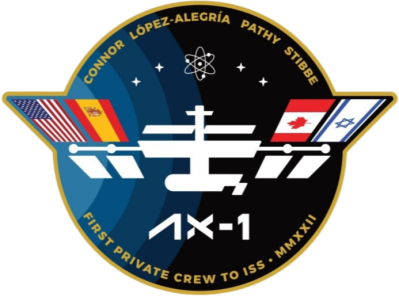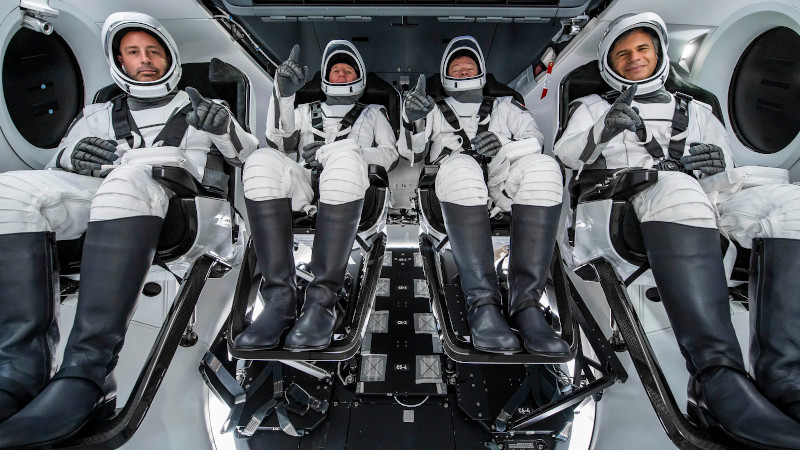In an era where anyone with deep enough pockets can hitch a ride to the edge of space and back, you’d be forgiven for thinking that Axiom’s Ax-1 mission to the International Space Station was little more than a pleasure cruise for the four crew members. Granted it’s a higher and faster flight than the suborbital hops that the likes of William Shatner and Jeff Bezos have been embarking on, but surely it must still be little more than a publicity stunt organized by folks with more money than they know what to do with?
 Thankfully, there’s a bit more to it than that. While the mission was privately funded, the Ax-1 crew weren’t just orbital sightseers. For one thing, there was plenty of real-world experience packed into the SpaceX Dragon: the mission was commanded by Michael López-Alegría, a veteran NASA astronaut, and crew members Larry Connor and Eytan Stibbe are both accomplished pilots, with the latter clocking in thousands of hours on various fighter jets during his time with the Israeli Air Force.
Thankfully, there’s a bit more to it than that. While the mission was privately funded, the Ax-1 crew weren’t just orbital sightseers. For one thing, there was plenty of real-world experience packed into the SpaceX Dragon: the mission was commanded by Michael López-Alegría, a veteran NASA astronaut, and crew members Larry Connor and Eytan Stibbe are both accomplished pilots, with the latter clocking in thousands of hours on various fighter jets during his time with the Israeli Air Force.
But more importantly, they had work to do. Each member of the crew was assigned a list of experiments they were to conduct, ranging from medical observations to the testing of new hardware. Of course there was some downtime — after all, if you spent $50 million on a ticket to space, you’d expect to have at least a little fun — but this wasn’t just a photo op: Axiom was looking for results. There was no hiding from the boss either, as López-Alegría is not just the Mission Commander, he’s also Axiom’s Vice President of Business Development.
Which makes sense when you consider the company’s ultimate goal is to use the ISS as a springboard to accelerate the development of their own commercial space station. The data collected during Ax-1 is going to be critical to Axiom’s path forward, and with their first module already under construction and expected to launch by 2025, there’s no time to waste.
So what did the crew members of the this privately funded mission to the International Space Station accomplish? Let’s take a look at a few of the more interesting entries from the docket.
Future Station Tech
While Axiom might technically be in the space tourism business at the moment, their goal is to eventually establish a destination for both government and commercial astronauts to perform space research and manufacturing. Rather than starting from scratch, they want to build onto the ISS with a series of modules that can eventually be detached and act as a free-flying station once the Station has officially been retired.
That being the case, it’s no surprise that Ax-1 crew was tasked with evaluating various technologies which would be useful on a near-future space station. Chief among them was a photocatalyst air purification device developed by the Japan Manned Space Systems Corporation (JAMSS). The device uses LEDs and a special filter medium to remove odors from the air, a problem that has long-plagued the 20+ year old orbiting laboratory.

Mission Specialist Mark Pathy was also tasked with studying two-way “holoportation”, a communication technology that allows the user to see a 3D representation of the person they are speaking with through an augmented reality headset.
NASA had previously tested a one-way version of the concept in October of last year, where callers from the ground would appear as if they were on the Station, but the Ax-1 mission debuted the ability for visuals to be transmitted from orbit. Allowing for more personal and interactive communication, NASA believes this tech will become increasingly valuable for long-duration spaceflight.
One of the technologies studied by Eytan Stibbe is a deployable high-gain antenna developed by Israeli startup company NSLComm. Designed so the reflector can be packed up tightly for launch, the antenna can only be tested in a microgravity environment. While primarily intended for small satellites, these sort of deployable structures have been considered a key technology for future orbital facilities and spacecraft.
Building In Space
Naturally, a commercial space station needs to have customers. To that end, technologies which take advantage of the unique microgravity environment offered by a permanent facility in low Earth orbit are of particular interest to Axiom.
Take for example the Fluidic Space Optics project which Eytan Stibbe was responsible for. In microgravity, filing a rigid frame with liquid polymer will naturally produce a perfect spherical shape due to surface tension. When cured with UV light, the result is an optical lens which on Earth could only be produced by laborious grinding and polishing. This technique could potentially allow the production of high quality optics at arbitrary scales, enabling the orbital construction of space telescopes which would be too large or fragile to launch from the ground.
Commander Michael López-Alegría also worked on a small scale demonstration of MIT’s concept for a self-assembling space architecture called the TESSERAE. The edges of which tile feature electropermanent magnets, and with the ability to maneuver autonomously, these tiles could connect to each other to create structures far larger than what could be packed into a rocket’s payload fairing. While obviously on the edge of what’s possible with current technology, TESSERAE is a fascinating look at how embracing microgravity could enable unique forms of extraterrestrial construction.
A Promising Start
Axiom currently has a contract with SpaceX to conduct three more flights to the ISS by 2023, all carrying four crew members. Little is publicly known about these future missions beyond the fact that NASA Astronaut Peggy Whitson will Command Ax-2 and race driver John Shoffner will serve as its Pilot. It’s also expected that two of the seats will go to reality show contestants, though as we learned from Mars One, any claims that have their source in the entertainment industry should be taken with a grain of salt.
Whoever ends up strapping into the Dragon on future Axiom missions, we can only hope they are held to the same standard as the crew of Ax-1. With commercial human spaceflight still in its infancy, the imperative should be to send the best and brightest of us on missions that have real impact and tangible benefits. Someday the average retiree might get the chance to chose between a European vacation and a short jaunt to orbit, but until then, there’s plenty of work to be done.
















Some funny things in that TESSERAE animation: anti-spinwise direct launch (let’s not even talk about the lack of a gravity turn), the first stage going along for the ride to mars (with RTLS fins and legs!), and then a 3-axis actuated clamshell fairing for the payload (which also would almost definitely come along for the ride to mars).
With the decision by the FAA to limit astronaut wings/badges only to those who have met certain requirements the cynic in me still mostly sees what most of them did as a limited attempt to get them their wings. None of it was imho particularly interesting or particularly required these people. Sure it off-loaded some work from the other ISS ‘nauts but that’s about it.
The relevant bit about the requirements (particularly item C):
“To be eligible for FAA Commercial Space Astronaut Wings,
commercial launch crewmembers must meet the following criteria:
a. Meet the requirements for flight crew qualifications and training under Title 14 of the
Code of Federal Regulations (14 CFR) part 460.
b. Demonstrated flight beyond 50 statute miles above the surface of the Earth as flight crew
on an FAA/AST licensed or permitted launch or reentry vehicle.
c. Demonstrated activities during flight that were essential to public safety, or contributed to
human space flight safety.”
(source: https://www [dot] faa [dot] gov/documentLibrary/media/Order/FAA_Order_8800.2.pdf)
“None of it was imho particularly interesting or particularly required these people.”
Yes, joy rides to space by million/billionaires are of absolutely zero interest to me.
Some of the experiments they are apparently running are pretty novel and unique so probably had dedicated education before launch so they can’t screw it up – not saying another person couldn’t have done it, but then by that argument anybody who gets to go to space could do it, if they spent the time training for that extra test/experiment…
All that makes these folks different is they can afford to subsidise the hardware they are using, rather than have to roll that nat 20 to be selected over all the other qualified hopefuls who want to get PAID to do the work… They still have to do all the training etc to actually do their job, and there are only so many hours in a day for the folks on the ISS longer term, they can’t do all the stuff that can possibly be done onboard now and all the training and study needed to do something coming up on the next supply mission or arrived on the last…
Maybe your inner cynic has a bit of a point, as no doubt they are not working as hard as PAID folks do – why pay and not get much time to experience what you paid for, but still…
This brings back memories of that documentary, “Pirates of Silicon Valley”, or how it was called.:
Their visit at the ISS kind of reminded me of the scene in which Apple makes an visit at Xerox.
Or the visit of Microsoft at Apple, later on.
They acted all nice and friendly, but their intentions were not.
My only question is: why do SpaceX suits come with riding boots? Or are these wellies in case of a space toilet malfunction?
To protect the wearers from snake bites.
“Snakes On A Pla^H^H^H Spaceship!”
“There’s snakes in space?”
https://www.youtube.com/watch?v=74oZIlMO218
I seriously don’t know. If I remember correctly from watching numerous documentaries of WW2 on the news channels (they air this stuff for years, dunno why), then the German military command in WW2 did wear similar boots, too. Along with leather gloves. Even though they usually did not ride horses, but used automobiles. I assume it’s all show. To make people think the wearers are an authority.
Attention Junior Space Persons: Get in on the action! https://www.ziprecruiter.com/jobs/axiom-space-inc-a75e7402/embedded-linux-software-engineer-45021143
I’m sorry, but if I was to pay that much money to go to space, I’m damn well going to enjoy a nice, quiet vacation. If they want me to work, they can damn well pay me.
Thank you for your application McFortner, the door is over there… Next!
Perfectly spherical lenses are of pretty limited utility. Check out the specs for high end camera lenses and they boast of how many aspheric elements they have. This is what you need to correct for various kinds of aberrations.
And apparently you are not aware, but lenses, even glass lenses, are routinely molded with no subsequent grinding and polishing. This is how aspheric lenses are for premium camera lenses (eg, Nikon, Canon, Leica).
So it was not vacation, it was unboxing and product testing like youtubers do down here ?